Prehistory
Advice from the magazine "jeux et stratégie" Some spare parts Reparing games The Tasc Smartboard
- Are you looking for a user manual ? The way to find it on this page.
- Are you looking for some price quotation ? The Ebay price archive is on www.elpeon.com
- Are you looking for technical specifications ? Take a visit to the wiki Schachcomputer (in German)
- Do you have a question ? The chesscomputer forum
I had a small collection of electronic chess games. It was a rolling collection: I was selling my games to buy and try other ones. I only kept very few of these games.
The first electronic chess games appeared around 1977/1978. the hardware was very expensive and not powerful. It's a period for prototypes, expensive, with a weak game level: these machines were knowing roughly the rules and that's all. This period ends around 1979, with the coming of Chess Challenger 7 and Sargon 2.5
For a Sunday player like me, these machines are still funny. They play weak moves (from an academic point of view) nut it's not so easy to build a strategic advantage on these errors: for instance, how to attack a king not able to castle anymore, how to react to a h7-h5 after the opening period ?
- Chess Traveller
- Graduate Chess
ADX Design
- Stratege
Applied Concepts Inc
- Boris
- Boris Diplomat
- Great Game Machine Sargon 2.5 & Morphy
- Morphy Encore
- Odin Encore
- Steinitz Edition 4
AVE Micro Systems
- Sargon 2.5 Auto Response Board
CXG / CGL / Schneider
- Alicante
- Chess 3000
- Chess Mate
- Chessmaster MK5
- Computachess II
- Computachess Travel Sensory
- Granada
- Madrid
- Portachess
- Portachess II
- Sensor Computachess
- Seville
Conchess
- Ambassador
- Escorter
- Monarch
Excalibur
- Alexandra the Great
- Chess Station
- Electronic Backgammon
- Grandmaster
- King Arthur
- Mirage
- Phantom Force
- Saber IV
- Touch Chess II
Fidelity Electronics
- Backgammon Challenger
- Bridge Challenger
- Bridge Challenger III
- Champion Sensory Challenger
- Checker Challenger
- Chess Challenger Voice
- Chess Challenger 3
- Chess Challenger 7
- Chess Challenger 9
- Chess Challenger 10
- Chesster Challenger
- Dame Challenger
- Designer 1500
- Designer 2000
- Designer display
- Eldorado
- Elite A/S
- Excel 68000
- Excel Display
- Excel Mach III
- Excellence
- Gambit
- Gin & Cribbage Challenger
- Marauder
- Micro Backgammon Challenger
- Micro Chess Challenger
- Mini Sensory Chess Challenger
- Par Excellence
- Reversi Sensory Challenger
- Sensory Chess Challenger 6
- Sensory Chess Challenger 8
- Super Nine
- Tiny Chess
- The classic CC8
- Ultimate Chess Challenge
- Voice Sensory Chess Challenger
Gakken, Lansay
- Computer Chess Game
Hegener & Glaser / Mephisto
- Mephisto
- Mephisto 2
- Mephisto Almeria
- Mephisto Berlin
- Mephisto Berlin Professional
- Mephisto Europa
- Mephisto Europa A
- Mephisto Europa A (Schachschule)
- Mephisto Genius 99
- Mephisto Junior
- Mephisto London
- Mephisto Lyon
- Mephisto Manhattan
- Mephisto Marco Polo
- Mephisto Milano
- Mephisto Mini
- Mephisto Mobil
- Mephisto Mobil LCD / MM-3000
- Mephisto Modena
- Mephisto Mondial II
- Mephisto Monte Carlo IV
- Mephisto Montreal 68000
- Mephisto MM I
- Mephisto MM II
- mephisto MM IV
- Mephisto MM IV / MM V turbo
- mephisto MM V
- Mephisto MM VI
- Mephisto Polgar
- Mephisto Portorose 68020
- Mephisto Risc II
- Mephisto Roma II
- Mephisto Vancouver
- My First Mephisto
- Schachcomputer 64
krypton
- Micro Chess
- Pioneer
Lansay
- Chess King Pocket Micro
Lexibook
- Chess Pro
- Chesslight
- ChessManLight
- ChessMan Pro
- LCD Computer Chess
- Travel Chess Explorer
Mattel
- Computer Chess
- Othello
Micro Games USA
- Backgammon 2
Millennium 2000 GmbH
- Chess & Games
- Karpov Schachpartner
- Orion 4 in 1
- Orion 6 in 1
- Orion Intelligent Chess
Milton Bradley
- Milton
Novag
- 2robot
- Agate
- Agate Plus
- Amber
- Amethyst
- Aquamarine Premier
- Beluga
- Chess Champion MK I
- Chess Champion MK II
- Chess Champion Super System III
- Chess Partner 2000
- Chess Printer
- Chinese Chess
- Citrine
- Condor
- Constellation 3.6 MHz
- Constellation Expert
- coral
- Diablo 68000
- Emerald Classic
- Escort
- Graphite (Pack Initation)
- Granite
- Jade
- Jasper
- Jasper Special
- Mentor 16
- Mentor Junior
- Micro Chess
- Micro II
- Obsidian
- Onyx
- Opal
- Opal II
- Piccolo
- Play with Mickey
- Presto
- Primo
- Ruby
- Sapphire
- Sapphire 2
- Secondo
- Solo
- Star Opal
- Star Sapphire
- Super Constellation
- Super Expert 6
- Super Expert B
- Super Expert C
- Super VIP
- Supremo
- Topaz
- Tourmaline
- Tourmaline Plus
- Turquoise
- Zircon
- Zircon II
Phoenix Chess System
- Resurrection II
Prinztronic
- Chess Traveller
Promedic Manufacturing Inc.
- Chess Master
Radiophon
- Chess Master
- Chess Master Diamond
RadioShack, Tandy, Go, Intertan
- 1450
- 1650
- 1650 fast response
- Super 1680L
- 1850
- 2 in 1 e-Chess and Checkers
- Chess Champion 2150
- Chess Champion 2150L
- Chess Champion 2250xl
- Compact Dames
- Computerized Chess Game
- Electronic Checkers
- Electronic Dames
- Master 2200x
Saitek
- 4 in 1
- Alchemist
- Aragon
- Atlas
- Blade
- Bravo
- Bridge Shadow
- Calculator Chess
- Capella
- Centurion
- Chess Companion
- Chess Companion III
- Chess Explorer
- Chess Partner 2
- Chess Shadow
- Coach Partner
- Compact Dames
- Conquistador
- Corona
- Dames Traveller
- Electronic Champion Backgammon
- Electronic Checkers
- Electronic Chess partner
- Electronic Chessman
- Electronic Dames
- Elite
- Explorer Pro
- Galileo Analyst C
- GK 2000
- GK 2100
- Handheld Champion Backgammon
- Junior Master Chess
- Kasparov Blitz
- Mephisto Chess Challenger
- Mephisto Chess Trainer
- Mephisto Maestro
- Mephisto Magellan
- Mephisto Master Chess
- Mephisto Senator
- Mephisto Solar Star
- Micro Travel Chess Computer
- MK 12 Trainer
- MK 14 Trainer
- Pocket Checkers
- Pocket Chess
- Pocket Plus
- President
- Pro Bridge 100
- Pro Bridge 200
- Talking Chess Trainer
- Schach-trainer
- Sensor Chess
- Sensor XL
- Sensory Backgammon
- Team Mate
- Travel Mate
- Turbo Advanced Trainer
- Virtuoso
SciSys
- Astral
- Concord II
- Chess Companion II
- Chess Intercontinental Traveler
- Chess Traveler
- Executive Chess
- Junior Chess
- Kasparov Plus
- Mini Chess
- MK 10
- MK 12
- Pocket Chess
- Pocket Plus
- Sensor Chess
- Rapier
- Superstar 28K
- Superstar 36K
- Turbo 16K
- Travel Mate
- Travel Sensor
Tiger
- Chess Grand Master
- Chess Marathon
- Electronic Galactic Chess
- Voice Master
Tsukuda
- Electronic Computer Othello
- Othello M-II
V-Tech
- Backgammon Master
Yeno
- 301 XL
- 320 XT
- 325 XL
- 416 XL
- 532 XL
- 540 XT
- Travel Chess
 In 1977, The Chess Challenger 1 was the first chess computer on the market. It was expensive and very limited:
there was only one game level and it played only black. The coordinate system was reversed: letters for lines and numbers for rows.
Officially produced at 1000 units, it's today a rare and expensive chess computer.
In 1977, The Chess Challenger 1 was the first chess computer on the market. It was expensive and very limited:
there was only one game level and it played only black. The coordinate system was reversed: letters for lines and numbers for rows.
Officially produced at 1000 units, it's today a rare and expensive chess computer.In 1977, the Chess Challenger 1 was replaced by the Chess Challenger 3 that has 3 levels. It is weak but does not make major tactical mistakes: see this test game. In 1977, the Chess Challenger 1 was sold around $800 and the Chess Challenger 3 $600. Less than 2 years after, the Chess Challenger 7 for $200, was a great commercial success.
Links:
- pictures of the Chess Challenger 1 and the Chess Challenger 3 on the site "Museo Español de computadotas de Ajedrez".
- and by Ismenio, a lot of details on the Chess Challenger 1 and on its differences with the Chess Challenger 3.
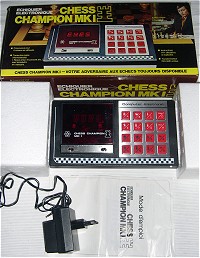 CHESS CHAMPION MK1 French
CHESS CHAMPION MK1 FrenchThis game was manufactured in 1978. It's a nice oldies collector with the red led display and the big buttons. It's also a very bad chess player. This game was well distributed and sold in Germany at a very low price at that time. But here is a very unusual French release with Karpov on the box. Click on the picture to see it bigger.
It's more an historical prototype than a real player: it only plays black. During a game, around 1 move every 4 time is bad but it also plays well sometime: see for instance this test game. It knows the rules but do not check if the human player respect them. The pawn promotion is made by editing the board, for instance: H 7 H 8 MD EP Queen (button 2) H 8 PLAY. It can not mate King + Queen against King. In the rulebook, it's recommended to play with a Queen handicap. Anatoly Karpov signed the following sentence: "This electronic chess game is a new partner, interesting, with surprising game variants". Surprising indeed.
CHESS CHAMPION MK1 German
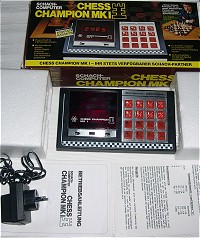
This game was first distributed in Germany: here is one of the first box still sponsored by Boris Spassky.
Some links:
Take the opportunity to look at Boris Spassky's games on chessgames.com
CC MK 1 in The Overtom Chess Computer Collection
CC MK 1 on the site of Ismenio Sousa
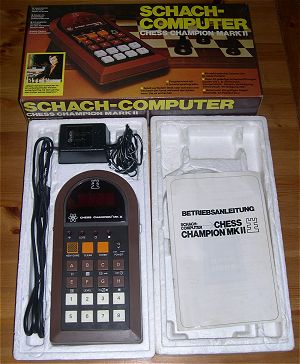 CHESS CHAMPION MK II
CHESS CHAMPION MK IIThe Chess Champion Mark II (1979) existed in 2 different packages: the rectangular one (visible here on www.overtom.nl) and "the big calculator". But only the rectangular release had a switch to turn off the sound and it was a game that makes a lot of noise. You can here the 4 notes indicating one move, the "chess" and the "chesmate" sounds.
This software had a small opening library but it was very weak, see this test game. Even when the player is very weak, the chess computer has difficulties to see the "mate in 1" moves.
Boris (Applied Concepts)

The Boris in its walnut wood box is from 1979. It included a 1 MHz processor and was famous for its useless comments. My prefered is "Dr Lasker I presume". During a first test game, I was surprised to see him playing well but during the second test game, it played badly with an opening phase mainly based on pawns movements.
This game was tested in Jeux et Stratégie n°1: The tester liked a lot its compact design in a wooden box, its nice display, the continous display of the prefered move during the calculation time; liked a little bit the chess clock and the comments not linked to what happens in the game; did not like at all the game level weaker than the Chess Challenger one and the very expensive price - around 2200F (330 euros).
More information is of course available on Daniel Collin' site: Boris is king.
Chess Master (Promedic / Consumenta)
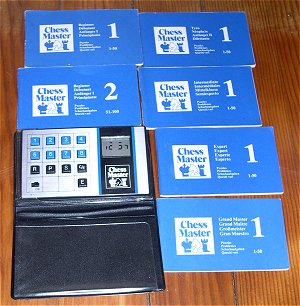 Out of order
Out of order(LCD display uncomplete)
This Chess Master is from 1979. This calculator is used only to solve chess problems printed in small booklets. It's not a player.
This calculator was published by Brett Campbell from a Canadian company "Promedic Manufacturing Inc." and distributed in Germany by "Consumenta Computer"
 Scisys Mini Chess (1981)
Scisys Mini Chess (1981)This Scisys Mini Chess "made in Hong Kong" is copyrighted "Scisys, 1981" and was distributed by Lansay in France. The software seems to be a simplified release of the Chess Traveller one: the display is similar and on both devices, the check position button is called FP.
It's a very simple device: 1 on off switch, 1 level switch (1 or 2), 1 multi-move switch (two player mode), clear, new Game, FP (to check positions) and the other buttons to enter the moves. Only the process to enter a position is more complex.
There will be no surprise: the game level is not very good. you can check it in this test game.
 Scisys Junior Chess
Scisys Junior ChessThere are different variants of this game including one called Scisys Junior Chess with an integrated travel chessboard (that looks a bit like the chess traveller one).
The Junior Chess was simply described in 1983 in Jeux et Strategie n°23: "Cheap, that's all". It was sold 350F (around €50, £35, $70).
Here is a test game.
Acetronic Graduate Chess
The Scisys Junior was distributed in UK under the name Acetronic Graduate Chess by Scisys. It's identical to the "integrated chessboard" Scisys Junior Chess:
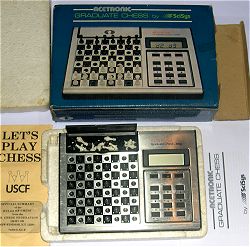

SENSOR COMPUTACHESS
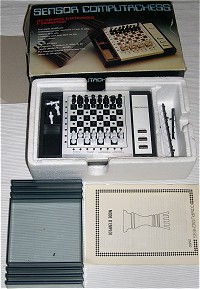
This Sensor Computachess has a French operating manual and is in a French box. The international name was usually CXG 001 Sensor Computachess. It's probably the first CXG computer chess. In fact, it was manufactured in Hong Kong (by Newcrest Technology Ltd ? White And Allcock ?) who distributed the games under several names: CXG, Hanimex, Systema, Schneider, Crown, Toytronic etc. In most of the case; tje operating manual has a white tower on the first page.
This travel game is nice to use because you just have to push the piece to indicate the move. But the game level is low - see this test game. This game propose 8 levels of play but at the higher level, it only takes 30s to answer.
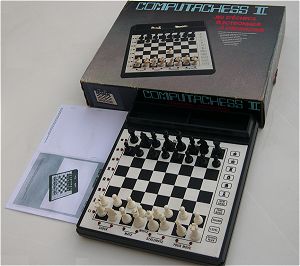 COMPUTACHESS II (1982)
COMPUTACHESS II (1982)The Computachess 2 looks like a bigger Computachess. It's a French release without CXG logo or any other brand information. There was also an international release with the logo CXG and another box.
The Computachess II has 8 game levels but they are more balanced than those of the Computachess: between 5s (level 1) and 14 mn (level 8).
The software is weak and not very agressive. Here is a test game: "easy and fun".
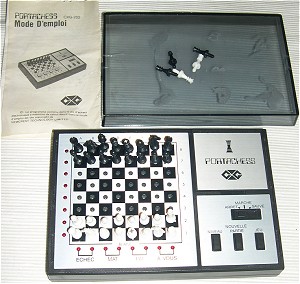 CXG PORTACHESS (1983)
CXG PORTACHESS (1983)The Portachess succeeded to the Computachess. There is a storage box under the Portachess logo for the game pieces. It proposed 16 levels of play. At level 16, it plays in less than one minute and it is again a very weak player. (see this test game).
It's a French release. The cover was damaged by glue. I do not have the packaging (visible here on a picture coming from Ebay)
CGL COMPUTACHESS TRAVEL SENSORY
(clone of CXG ADVANCED PORTACHESS)
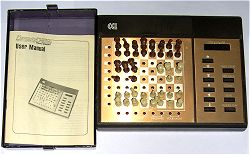
This CGL Computachess Travel Sensory comes from United Kingdom. It's probably very similar to the CXG Advanced portachess and is identical to the Hanimex Computachess II (HCG 1600) from 1982. But it has nothing to do with the CXG Computachess II. Easy ? As an overview, CXG built the Computachess then the Computachess II followed by the the Portachess and the Advanced Portachess. The other brands just mixed the different names.
This game contains 8 levels between 5s and 14mn per move. It plays better than the Computachess and the Portachess but is still very weak as demonstrated in this test game.
 Sensor Chessmaster MK5 (Schneider)
Sensor Chessmaster MK5 (Schneider)The Schneider MK5 is probably a simplified version of the CXG Crown with the program CXG Advanced portachess. It has also 8 levels and the same buttons. However, on this mk5, the buttons with chess figures are not working. It may be a design limitation or a manufacturing mistake.
At the maximium level, it has some weaknesses in the opening phase and an agressive unorganized game style: see this test game.